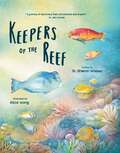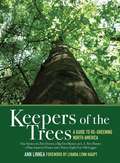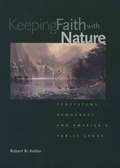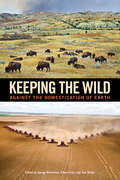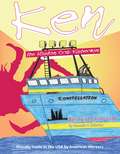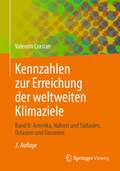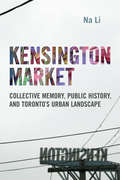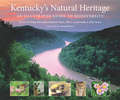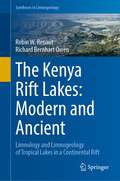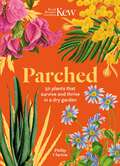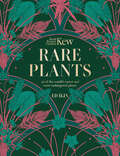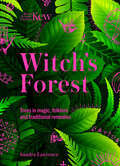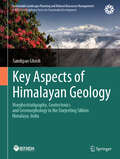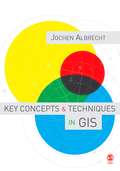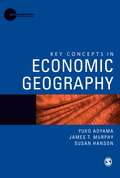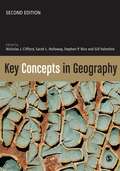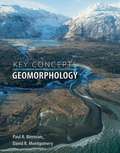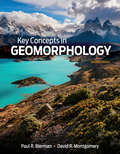- Table View
- List View
Keeper Of The Swamp
by Ann GarrettAboy and his ailing grandfather pole a small boat out into the Louisiana bayou. Suddenly, they spot Boots, a female alligator the grandfather saved from poachers years ago. <P><P>How will the boy face the danger in learning to take care of this wild creature? Strikingly illustrated with artwork that combines oil painting and computer imaging, Keeper of the Swamp is a scary and satisfying tale that carries a strong environmental message.
Keepers of the Reef
by Sharon WismerTakes children to the underwater world of Australia's Great Barrier Reef for a prime example of how a complex ecosystem depends on its keystone species. Sharon Wismer—reef ecologist and mom—is the best tour guide a kid could have for a visit to the underwater world of Australia’s Great Barrier Reef. Alice Wong’s richly detailed, accurate watercolors take a boy and girl snorkeling to see the fishes that maintain the ecological balance between the corals and their main competitor, algae. Without the fish species that brush, crop, scrape, excavate, and browse the algae, coral reefs would die. A coral reef is a brilliant and colorful example of how a complex ecosystem functions and why its keystone species are critical to its health. The Great Barrier Reef is one of Earth’s most celebrated natural treasures. Here children discover why the reef is threatened and what we can all do to help protect it. Endorsements are coming from Charlie Veron (“the godfather of coral,” featured in the 2017 film Chasing Coral) and David Bellwood, a world-renowned reef fish ecologist whose lab is the source of much of the information in this book. Keepers of Reef is the rare children’s book combining cutting-edge science with narrative and pictorial magic. Thorough backmatter sources and resources are included.
Keepers of the Trees: A Guide to Re-Greening North America: True Stories of a Tree Doctor, a Big Tree Hunter, an L.A. Tree Planter, a Plant Amnesty Pruner, and a Ninety-Eight-Year-Old Logger
by Lyanda Lynn Haupt Ann LinneaEngage in the life stories of fourteen people whose lives have been shaped by trees-featuring the true stories of a tree doctor, big tree hunter Will Blozan, Plant Amnesty's pruner, and ninety-four-year-old logger Merve Wilkinson. Also interviewed is Vietnam veteran Bud Pearson, whose post-traumatic stress disorder found healing and acceptance as a wood carver in the wilds of Montana, as well as Andy Lipkis, founder of TreePeople, who has spent thirty-five years ripping up concrete in L.A. to plant over two million trees in an effort to stop flooding and reduce air pollution. Each tree keeper reveals the inspiration and organization behind their advocacy with detailed explanations and touching stories of how their lives have come to be shaped by the forests they are fighting to preserve. Keepers of the Trees includes stories from all over North America, including Vancouver, Chicago, L.A., and Montana. This book includes one hundred color photographs of the tree keepers in action as well as diagrams illustrating the keepers' work. These are inspirational stories of conservation, healing, passion, and advocacy for any classroom, conservationist, activist, and nature lover.
Keeping Close to Nature's Heart
by Carollyne HutterEvery visitor of Yosemite National Park in California should say "thank you" to one man: John Muir.
Keeping Faith with Nature: Ecosystems, Democracy, and America's Public Lands
by Robert B. KeiterAs the twenty-first century dawns, public land policy is entering a new era. This timely book examines the historical, scientific, political, legal, and institutional developments that are changing management priorities and policies--developments that compel us to view the public lands as an integrated ecological entity and a key biodiversity stronghold. Once the background is set, each chapter opens with a specific natural resource controversy, ranging from the Pacific Northwest's spotted owl imbroglio to the struggle over southern Utah's Colorado Plateau country. Robert Keiter uses these case histories to analyze the ideas, forces, and institutions that are both fomenting and retarding change. Although Congress has the final say in how the public domain is managed, the public land agencies, federal courts, and western communities are each playing important roles in the transformation to an ecological management regime. At the same time, a newly emergent and home-grown collaborative process movement has given the public land constituencies a greater role in administering these lands. Arguing that we must integrate the new imperatives of ecosystem science with our devolutionary political tendencies, Keiter outlines a coherent new approach to natural resources policy.
Keeping the Air Clean
by John BainesKEEPING THE AIR CLEAN. If we don't stop pumping greenhouse gases into the air, by 2100 the earth may be 7 degrees F (4 degrees C) warmer. Without air there would be no life on our planet, yet we are now poisoning the air we breathe. It isn't too late; if we act now, there is still time to repair the damage we have done. The world's seven richest countries are responsible for one third of global warming. In Norway 92 percent of the air pollution that causes acid rain is blown in from other countries. If we stop producing CFCs now, the ozone layer could recover by 2050.
Keeping the Wild: Against the Domestication of Earth
by Tom Butler George Wuerthner Eileen CristIs it time to embrace the so-called "Anthropocene"--the age of human dominion--and to abandon tried-and-true conservation tools such as parks and wilderness areas? Is the future of Earth to be fully domesticated, an engineered global garden managed by technocrats to serve humanity? The schism between advocates of rewilding and those who accept and even celebrate a "post-wild" world is arguably the hottest intellectual battle in contemporary conservation. In Keeping the Wild, a group of prominent scientists, writers, and conservation activists responds to the Anthropocene-boosters who claim that wild nature is no more (or in any case not much worth caring about), that human-caused extinction is acceptable, and that "novel ecosystems" are an adequate replacement for natural landscapes. With rhetorical fists swinging, the book's contributors argue that these "new environmentalists" embody the hubris of the managerial mindset and offer a conservation strategy that will fail to protect life in all its buzzing, blossoming diversity. With essays from Eileen Crist, David Ehrenfeld, Dave Foreman, Lisi Krall, Harvey Locke, Curt Meine, Kathleen Dean Moore, Michael Soulé, Terry Tempest Williams and other leading thinkers, Keeping the Wild provides an introduction to this important debate, a critique of the Anthropocene boosters' attack on traditional conservation, and unapologetic advocacy for wild nature.
Ken the Alaskan Crab Fisherman: Bering Sea King Crab
by Ken BottcherI am truly blessed to be living in the most beautiful place on God's green earth, Valdez, Alaska. Valdez is located in Prince William Sound on Alaska's Gulf coast and is surrounded by natural beauty unequaled, in my opinion, anywhere else on earth. Though my commercial fishing days are far behind me in life, I truly enjoy writing stories I hope inspire children to work hard and follow their dreams.
Kennzahlen zur Erreichung der weltweiten Klimaziele: Band II: Amerika, Nahost und Südasien, Ostasien und Ozeanien
by Valentin CrastanAnalysiert werden die aktuellen Kennzahlen aus der Energiewirtschaft für die geographischen Einheiten Amerika – unterteilt in Nordamerika (Kanada + USA) sowie Mittel- und Südamerika –, Nahost und Südasien sowie Ostasien und Ozeanien. Die wichtigsten energiewirtschaftlichen Indikatoren der einzelnen Regionen und Länder und deren Entwicklung werden in zahlreichen Grafiken und Energieflussdiagrammen veranschaulicht. Darauf basierend empfiehlt der Autor eine Verteilung der zur Begrenzung des Klimawandels notwendigen Emissionsreduktion (für Klimaziel 2 °C und 1,5 °C, mit Perspektive bis 2050).Die in diesem Band behandelten Erdteile verursachen zusammen 77 % der Emissionen. Europa + Eurasien sowie Afrika werden in einem weiteren Band behandelt.
Kensington Market
by Na LiSince the beginning of the twentieth century, Toronto's Kensington Market neighbourhood has been home to a multicultural mosaic of immigrant communities: Jewish, Portuguese, Chinese, South Asian, Caribbean, and many others. Despite repeated transformations, the neighbourhood has never lost its vibrant, close-knit character.In Kensington Market, urban planner and public historian Na Li explores both the Market's dynamic history and the ways in which planners can access the intangible collective memory that helps define neighbourhoods like it around the world. Through examinations of memorable Kensington landmarks such as the Kiev Synagogue, Hyman's Bookstore, and United Bakers Dairy Restaurant, Li traces the connections between the Market's built environment and the experiences of its inhabitants, providing a sterling example of how to map the intangible value of this national landmark.Li's book will be a must-read for those fascinated with this iconic Toronto neighbourhood, as well as anyone with an interest in the role heritage and collective memory can play in urban planning.
Kentucky Agate: State Rock and Mineral Treasure of the Commonwealth
by Roland L. McIntosh Warren H. AndersonThis informative and fully illustrated volume explores the untold story of agate gemstones hidden in Kentucky’s scenic Knobs Region.With their fine grain and rich assortment of colors, agate stones are coveted by collectors and becoming rarer across the globe. Some of the most beautiful specimens in the world have been found in the rugged terrain of eastern Kentucky. In Kentucky Agate, authors Roland L. McIntosh and Warren H. Anderson reveal the beauty and diversity of this sought-after stone with hundreds of color photographs.Kentucky Agate also reveals locations where agate may be found, offering maps of the region surrounding the city of Irvine, Kentucky, including parts of Estill, Powell, Jackson, Menifee, Madison, and Lee counties. With detailed photographs revealing aspects of the rock not visible to the naked eye, this book also provides fascinating information on the history, geology, chemistry, and formation of the mineral.
Kentucky's Natural Heritage: An Illustrated Guide to Biodiversity
by Greg Abernathy Deborah White Ellis L. Laudermilk Marc Evans“[A] beautiful book about a state that has just about everything except a beach: mountains, swamps, rivers, plains, and, of course, the lovely bluegrass.” —Baton Rouge AdvocateKentucky’s abundance of plant and animal life, from the bottomland swamps in the west to the rich Appalachian forests in the east, is extraordinary as well as beautiful. Glades, prairies, forests, wetlands, rivers, and caves form a biologically diverse patchwork that is unique to the state. Kentucky’s Natural Heritage: An Illustrated Guide to Biodiversity provides an essential reference to the remarkable natural history of the commonwealth and is a rallying call for the conservation of this priceless legacy.Kentucky’s ecosystems teem with diverse native species, some of which are found nowhere else in the world. Kentucky’s Natural Heritage brings these sometimes elusive creatures into close view, from black-throated green warblers to lizard skin liverworts. The aquatic systems of the state are home to rainbow darters, ghost crayfish, salamander mussels, and an impressive array of other species that constitute some of the greatest levels of freshwater diversity on the planet.Richly detailed and lavishly illustrated with more than 250 color photos, maps, and charts, Kentucky’s Natural Heritage is the definitive compendium of the commonwealth’s amazing diversity and presents a persuasive argument for the necessity of conservation. Organized by a team from the Kentucky State Nature Preserves Commission, the book is an outgrowth of the agency’s focus on biodiversity protection.“Between its covers, readers will find details of Kentucky’s vanished natural areas and catalogue of the increasingly rare animal, plants and unique habitats that urgently need protection.” —Louisville Courier Journal
The Kenya Rift Lakes: Limnology and Limnogeology of Tropical Lakes in a Continental Rift (Syntheses in Limnogeology)
by Robin W. Renaut Richard Bernhart OwenThis book is the first comprehensive account of the modern Kenya Rift Valley lakes and their precursor lakes preserved in the sedimentary record. The first part gives the broad geological and environmental background to the Kenya Rift and a history of research. In the second part, each modern lake is described from perspectives of geology, limnology, ecology, sedimentology and late Quaternary history. The fossil lake sediments, some linked to hominin sites, and their paleoenvironmental history are considered in the third part. In the fourth section, the global tectonic, volcanic and climate controls of lake evolution in continental rifts are examined. The last section discusses the resource potential of the lakes and their sediments, and the environmental issues that currently affect the modern lakes. This research-level book (geology, paleoecology) is illustrated throughout by original figures and photographs.
Kew - Parched: 50 plants that thrive and survive in a dry garden
by Philip ClaytonDazzling, diverse, durable - discover the remarkable drought-proof plants that flourish in the driest environments.With rainfall unpredictable and summers increasingly hot, plants that survive and thrive in these conditions have become more important than ever. Through expert text and beautiful botanical illustrations from the archives of the Royal Botanic Gardens, Kew, Parched explores the captivating variety that exists in the world of dry plants. From poppies and palms to cypress and cyclamen, this stunning book showcases the incredible species that have become a mainstay of dry gardens around the world.
Kew - Parched: 50 plants that thrive and survive in a dry garden
by Philip ClaytonDazzling, diverse, durable - discover the remarkable drought-proof plants that flourish in the driest environments.With rainfall unpredictable and summers increasingly hot, plants that survive and thrive in these conditions have become more important than ever. Through expert text and beautiful botanical illustrations from the archives of the Royal Botanic Gardens, Kew, Parched explores the captivating variety that exists in the world of dry plants. From poppies and palms to cypress and cyclamen, this stunning book showcases the incredible species that have become a mainstay of dry gardens around the world.
Kew - Rare Plants: The world's unusual and endangered plants
by Ed Ikin Royal Botanic Kew"Some plants are inherently rare, while others become rare through our actions."Rare Plants explores what makes the world's most uncommon plants so exceptional, and by what means they have become so scarce. From highlands to jungles, many of our most extraordinary plants are vanishing at shocking rates, and this exquisitely illustrated book explores 40 of these mysterious species.Featuring stunning archive images and expert insight from the Royal Botanical Gardens, Kew, Rare Plants explores both the beauty and necessity of our endangered plant life.
Kew - Rare Plants: The world's unusual and endangered plants
by Ed Ikin Royal Botanic Kew"Some plants are inherently rare, while others become rare through our actions."Rare Plants explores what makes the world's most uncommon plants so exceptional, and by what means they have become so scarce. From highlands to jungles, many of our most extraordinary plants are vanishing at shocking rates, and this exquisitely illustrated book explores 40 of these mysterious species.Featuring stunning archive images and expert insight from the Royal Botanical Gardens, Kew, Rare Plants explores both the beauty and necessity of our endangered plant life.
Kew - Witch's Forest: Trees in magic, folklore and traditional remedies
by Royal Botanic Kew Sandra LawrenceThere is more folklore, mythology and magic associated with our trees and forests than with any other living things.Known throughout the world as dark and wild places where witches make mischief and eerie creatures dwell, forests are also places of sanctuary for the ancient magic and the most enchanting species of trees.Kew: Witch's Forest is a beautifully illustrated, captivating journey through the magical woodland and its stories, from birch broomsticks and the sacred olive, to alder doorways and the Tree of Life.
Kew - Witch's Forest: Trees in magic, folklore and traditional remedies
by Royal Botanic Kew Sandra LawrenceThere is more folklore, mythology and magic associated with our trees and forests than with any other living things.Known throughout the world as dark and wild places where witches make mischief and eerie creatures dwell, forests are also places of sanctuary for the ancient magic and the most enchanting species of trees.Kew: Witch's Forest is a beautifully illustrated, captivating journey through the magical woodland and its stories, from birch broomsticks and the sacred olive, to alder doorways and the Tree of Life.
Key Aspects of Himalayan Geology: Morphostratigraphy, Geotectonics and Geomorphology in the Darjeeling Sikkim Himalaya, India (Sustainable Landscape Planning and Natural Resources Management)
by Sandipan GhoshThis book serves as a ready reference book for anyone who is interested in the Himalayan geology and apprises the readers with the latest findings. The Himalayan syntaxes compose about one-third of the India-Asia collision zone and encompass a substantial part of the crustal deformation that occurs within the system. The Darjeeling Sikkim Himalaya (DSH) marks the beginning of the Eastern Himalaya, which is the most active orogenic zone, coupled with variable seismicity. It is located between Bhutan to the east and Nepal to the west. In the west, Sikkim shares Kanchenjunga, Earth's third highest mountain, with Nepal, while the ridge line forming Sikkim's eastern border flanks the Yadong-Gulu rift graben. DSH, craved by the river system of Tista, is a large geodynamic laboratory of nature where orogen is still in youth to early mature phases of evolution. Giant-scale endogenous turmoil thoroughly overhauled terrain mostly within the confines of distinct belts or divisions and spectacularly uplifted the terrain in superlative terms. Resting on the foundation of structure, tectonics, geomorphology, stratigraphy, and evolution, the wings of geology extend much further. Several books, mostly having regional approaches of different scales, have been written on the Himalayan geology with specified intentions. Geological Aspects of the DSH is based on more than direct references and succinctly opens a gateway to variable aspects of mineral study, active tectonics, crustal deformation, tectono-stratigraphy, seismicity, sedimentary geology, palaeontology, landslides, and tectonic geomorphology. The book apprises the readers with the latest findings. The book is addressed to university students for their academic needs and to those who are willing to work in Himalayan terrain. The large number of topics covered in this book is hardly available in any other single book so far. Anyone interested in the geology of the Himalaya might use the book as a quick reference. Different Dimensions of Geology and Geomorphology are described in nine key chapters.
Key Concepts and Techniques in GIS
by Jochen AlbrechtKey Concepts and Techniques in GIS is a concise overview of the fundamental ideas that inform geographic information science. It provides detailed descriptions of the concepts and techniques that anyone using GIS software must fully understand to analyse spatial data. Short and clearly focussed chapters provide explanations of: spatial relationships and spatial data the creation of digital data, the use and access of existing data, the combination of data the use of modelling techniques and the essential functions of map algebra spatial statistics and spatial analysis geocomputation - including discussion of neural networks, cellular automata, and agent-based modelling Illustrated throughout with explanatory figures, the text also includes a glossary, cross referenced to discussion in the text. Written very much from a user′s perspective, Key Concepts and Techniques in GIS is highly readable refresher course for intermediate level students and practitioners of GIS in the social and the natural sciences.
Key Concepts in Economic Geography (Key Concepts in Human Geography)
by Yuko Aoyama James T Murphy Susan Hanson"A comprehensive and highly readable review of the conceptual underpinnings of economic geography. Students and professional scholars alike will find it extremely useful both as a reference manual and as an authoritative guide to the numerous theoretical debates that characterize the field." - Allen J. Scott, University of California "Guides readers skilfully through the rapidly changing field of economic geography... The key concepts used to structure this narrative range from key actors and processes within global economic change to a discussion of newer areas of research including work on financialisation and consumption. The result is a highly readable synthesis of contemporary debates within economic geography that is also sensitive to the history of the sub-discipline." - Sarah Hall, University of Nottingham "The nice thing about this text is that it is concise but with depth in its coverage. A must have for any library, and a useful desk reference for any serious student of economic geography or political economy." - Adam Dixon, Bristol University Organized around 20 short essays, Key Concepts in Economic Geography provides a cutting edge introduction to the central concepts that define contemporary research in economic geography. Involving detailed and expansive discussions, the book includes: An introductory chapter providing a succinct overview of the recent developments in the field. Over 20 key concept entries with comprehensive explanations, definitions and evolutions of the subject. Extensive pedagogic features that enhance understanding including figures, diagrams and further reading. An ideal companion text for upper-level undergraduate and postgraduate students in economic geography, the book presents the key concepts in the discipline, demonstrating their historical roots and contemporary applications to fully understand the processes of economic change, regional growth and decline, globalization, and the changing locations of firms and industries. Written by an internationally recognized set of authors, the book is an essential addition to any geography student′s library.
Key Concepts in Geography
by Gill Valentine Nicholas J. Clifford Sarah L. Holloway Stephen P. RiceIncluding ten new chapters on nature, globalization, development and risk, and a new section on practicing geography, this is a completely revised and updated edition of the best-selling, standard student resource. Key Concepts in Geography explains the key terms - space, time, place, scale, landscape - that define the language of geography. It is unique in the reference literature as it provides - in one volume - concepts from both human geography and physical geography; especially relevant now that environment is so critical to our understanding of geography. Four introductory chapters on different intellectual traditions in geography situate and introduce the entries on the key concepts. Each entry then comprises a short definition, a summary of the principal arguments, a substantive 5,000-word discussion, the use of real-life examples, and annotated notes for further reading. Written in an accessible way - by established figures in the discipline - the definitions provide thorough explanations of key geographical concepts. Each discussion provides references to, and summaries of, the key literature; as well as an examination of the history and use of each concept, illustrated with everyday examples. Key Concepts in Geography is a comprehensive overview of the all the core concepts that undergraduates of geography must understand to complete their degree.
Key Concepts in Geomorphology
by Paul R. Bierman David R. MontgomeryWritten for introductory geomorphology courses, Key Concepts in Geomorphology offers an integrative, applications-centered approach to the study of the Earth’s dynamic surface. Bierman and Montgomery draw from the fields of physics, chemistry, biology, and mathematics to help students get a basic understanding of Earth surface processes and the evolution of topography over short and long timescales. The authors also hone in on practical applications, showing how scientists are using geomorphological research to tackle critical societal issues (natural disaster response, safer infrastructure, protecting species, and more).
Key Concepts in Geomorphology
by David Montgomery Paul BiermanDeveloped with extensive community involvement and support from the US National Science Foundation, it is about our planet’s dynamic surface, a place where Earth and atmosphere meet and life thrives. Key Concepts in Geomorphology takes an integrative science approach that applies principles of physics, chemistry, biology, and mathematics in the understanding of Earth surface processes and the evolution of topography over short and long timescales to solve problems important to people and societies. The authors also hone in on practical applications, showing how scientists are using geomorphological research to tackle critical societal issues (natural disaster response, safer infrastructure, protecting species, and more).

